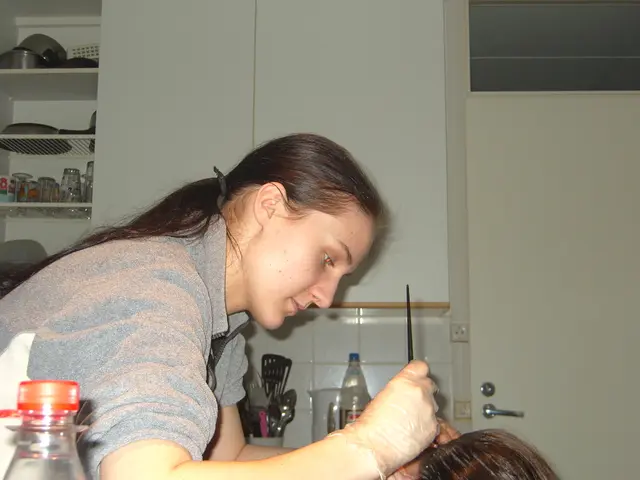Distinguishing Age Spots from Skin Cancer: Recognizing the Signs Differently
Let's Set Things Straight:
Aging can bring about various changes, one of which is the appearance of age spots on the skin. These unsightly marks can look like certain types of skin cancer, but don't fret! They're typically harmless and not a cause for concern.
Both age spots and skin cancer are more likely to appear on areas that receive regular sun exposure, like your mug, hands, or back. Recognizing the differences between these two conditions is vital to ensure you're keeping tabs on your skin health. Here's the lowdown:
Age Spots vs Skin Cancer:
Unlike skin cancer, age spots aren't a cause for alarm – they don't require treatment or removal as they're harmless.
Age Spots 101:
Age spots, or solar lentigines, manifest as darker patches on the skin, usually appearing as brown, black, or gray spots. They're typically smooth, flat, and won't itch or feel rough. They're caused by the body producing excess melanin to protect the skin from UV radiation. Interestingly, age spots usually occur in middle age and, while they're more common on lighter skin, they can appear on any skin tone.
Skin Cancer in a Nutshell:
Skin cancer is a type of cancer that can develop as a result of UV radiation damage from the sun or tanning beds. It forms when skin cells get damaged, mutate, and grow and spread at an accelerated rate. Skin cancer is harmful and can spread to other parts of the body, which is why it's crucial to stay vigilant. The three most common types of skin cancer are basal cell carcinoma, squamous cell carcinoma, and melanoma.
Another type of mark that may resemble an age spot is actinic keratosis – a precancerous growth that occurs due to UV radiation damage. It's essential to keep an eye on any new or changing marks on your skin and consult with a healthcare professional if you notice any signs of skin cancer or actinic keratosis.
Can Age Spots Turn into Cancer?
No way, José! Age spots cannot transform into skin cancer. However, actinic keratosis, which can appear similar to age spots, is a precancerous growth that, if left untreated, may progress to skin cancer.
Symptom Comparison:
Age spots are smooth, flat, yellow, brown, gray, and defined with clear borders. They're generally between a few millimeters or centimeters in size and often appear on sun-exposed areas like your face, hands, shoulders, and back. On the other hand, skin cancer symptoms can vary and include asymmetrical shapes, multiple colors, bleeding, and unexplained changes in the spot's appearance.
When to Contact a Doc:
If you notice any unusual changes to your skin, it's always best to consult with a healthcare professional. Prompt diagnosis can make skin cancer treatment more effective and improve your chances of a positive health outcome. Reach out to a doc if you notice any signs of malignant growths, such as changes in color, shape, size, or location, or moles that itch, crust over, or bleed and don't heal within four weeks.
Diagnosis and Treatment:
A doctor or dermatologist performs a physical examination to diagnose age spots. If the doctor isn't sure, they may perform a skin biopsy to test for other conditions like skin cancer or actinic keratosis. The results of a skin biopsy will indicate whether you have skin cancer or another skin condition.
Treatment options depend on the type and severity of the condition. Age spots usually don't require medical treatment but may be treated for cosmetic reasons using creams, chemical peels, laser therapy, or topical treatments. Skin cancer treatments often include surgical removal, radiation therapy, chemotherapy, immunotherapy, or systemic medication.
In summary, age spots and skin cancer have differences in their appearance, symptoms, and treatment. Being aware of these differences will help you stay on top of your skin health. If you notice any unusual changes to your skin, consult with a healthcare professional for early detection and effective treatment.
- Seniors should be aware that both age spots and certain types of skin cancer, such as melanoma, may appear as dark patches on the skin, especially on areas exposed to the sun.
- In the field of dermatology, it's important to distinguish age spots from skin cancer, as the latter can be a serious medical-condition.
- Health-and-wellness conscious individuals should be knowledgeable about various skin-care issues, including skin-conditions like age spots and skin cancer, to assure proper skin care and early detection.
- Science reveals that excessive melanin production in the skin due to UV radiation is responsible for both age spots and some types of skin cancer, emphasizing the importance of sun protection.
- The oncology community agrees that even though age spots are typically harmless, it's crucial to consult with healthcare professionals regarding any unusual skin-conditions or changes, to ensure timely diagnosis and treatment of conditions like skin cancer or precancerous growths.








